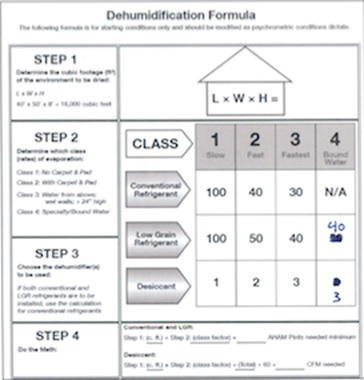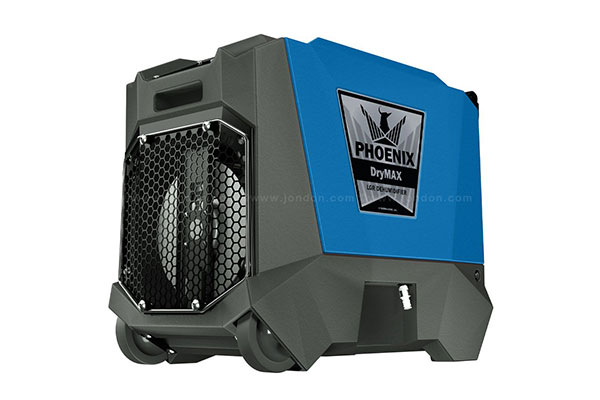The job of a dehumidifier is to remove moisture from the air. It’s that simple! It gets a little more scientific when you must understand which type of dehumidifier a situation requires, the water removal capability that is required, and where to place the dehumidifier so that it works most efficiently. Also you need to be able to determine if one dehumidifier is enough, or will you need more than one?
You also need to take into consideration whether or not the rate of evaporation is occurring faster than the rate of dehumidification. If that takes place, secondary damage can occur due to the fact that you are saturating the air with more moisture than you are getting rid of.
Types of Dehumidifiers
Conventional Refrigerants – these are the most basic portable dehumidifiers. They work by removing water from the air through condensation. They pull air across cold internal coils. When this air cross over the surface of the coils the air temperature is lowered below the dew point and the moisture vapor in the air changes from a gas to a liquid and condensates on the coils. They are more efficient in high humidity conditions and work best at temperatures between 70° and 90°.
These are the types of dehumidifiers that many homeowners purchase at home improvement stores. They work well when they are used mainly to maintain humidity levels under normal circumstances, not necessarily in times of larger water losses.
These types of dehumidifiers run into trouble when they have to dry bound water. In this case, bound water is the moisture trapped in saturated structural materials like drywall and wood. Conventional refrigerant dehumidifiers just can’t get the environment dry enough to cause this moisture to release from these types of materials.
Low Grain Refrigerants (LGR’s) – these are the workhorses of the water damage restoration industry. They are very efficient and work well in higher humidity situations and then continue performing well as conditions begin to dry out. They produce lower vapor pressures (measured in Grains Per Pound, or GPP) and will keep drying the air when conventional refrigerants will stop.
The LGR can accomplish this low-grain drying because they have a pre-cooling device that allows the dehumidifier to work with cooler air as it crosses their coils. The operate most efficiently in the same temperature ranges as conventional refrigerants, but will remove more moisture at lower humidity levels. That is why LGR’s are the best choice for most drying situations.
There are also LGR’s that are called “high-heat” dehumidifiers. They will continue to work in temperatures between 90° and 125°however their efficiency begins to decrease as temperatures rise above 90°.
Desiccant Dehumidifiers – these use a chemical attraction method of removing moisture rather than condensation. They are less limited by temperature and low dew points and can produce the driest air of any dehumidifier.
Desiccants are used to dry in specific situations where the wet materials are very dense, like hardwood floors and plaster walls. They are ideal for extremely large losses that contain lots of cubic footage. They can be as small as a large suitcase or the size of a tractor trailer. They also work well in crawlspaces.
Where to Use Which Dehumidifier
When determining which kind of dehumidifier to use under what condition, several factors come into play. The most important factors are what is wet, the size of the area to be dried, and how much moisture is present. Below are some basic guidelines to dehumidifier usage:
Conventional Refrigerants
- Small losses with little wet materials
- In an effort to maintain humidity levels, like a below-grade room or basement
Low Grain Refrigerants (LGR’s)
- Residential and smaller commercial losses
- Warm, humid conditions
- Instances involving removal of bound water
Desiccant Dehumidifiers
- Difficult drying conditions
- Large commercial losses with lots of cubic footage; warehouses, office buildings, etc.
- In temperatures that would cause LGR’s to be ineffective
The Number of Dehumidifiers Required
In no case do you want humidity levels to linger at or above 60% RH (relative humidity. First you must determine the cubic feet of the affected area. Next determine the class of the water loss. Classes range from 1 to 4:
- Class 1 has very little water and no wet carpet and pad involved.
- Class 2 has wet carpet and pad.
- Class 3 has wet carpet and pad and wet walls.
- Class 4 has everything in class 3 and may include water that comes down from above or specialty drying situations like wet and warping hardwood floors.
After these determinations you need to be able to have access to a dehumidification factor chart. You divide the cubic feet by the factor to calculate the number of pint removal required. Then divide this number by the removal rating for the dehumidifier you are using. For example if the answer is 330 pints required and you dehumidifier is rated at 100 pints, you would need four dehumidifiers (remember to always round up) to do the job.

Desiccants work on a different principle, CFM’s, or cubic feet per minute.. For a desiccant use the appropriate factor multiplied by the cubic feet then divide by 60 (60 minutes in an hour) to calculate the require number of CFM’s. Compare the desiccant’s CFM output to what is required and use the proper number of desiccants.
Never double the number of dehumidifiers required for a job. Too many will cause heat build-up problems over time as materials get dryer and dryer.
Conclusion
The purpose of using a dehumidifier in a water loss is to return the affected areas to a relative humidity of 40% or less in 24 hours. If that can be achieved, mold growth will be greatly inhibited. Nature is always attempting to be in equilibrium. Hot moves to cold and wet moves to dry, if it can. The drier the air, the faster moisture will move into the air and the faster materials will dry.
If you are a homeowner with a below-grade room that seems to always have higher humidity or a musty odor, a conventional refrigerant dehumidifier will do a good job for you. These smaller dehumidifiers do a great job of maintaining humidity and reducing the chance of mold growing in the area. For convenience sake, use a dehumidifier that you can attach a hose to so that it will continuously drain away any water it collects. The dehumidifier won’t do you any good if the water container fills up and overflows.
Our expert water restoration technicians at Water Mold Fire Restoration have the training, certifications, and experience to help you with any kind of water emergency. We answer our phones 24/7 and can be on site in one hour or less. No emergency is considered too small or too large. Call us at 800-905-0277 or contact us by email at help@watermoldfire.net. Our initial inspection and advice is always without charge or obligation.








